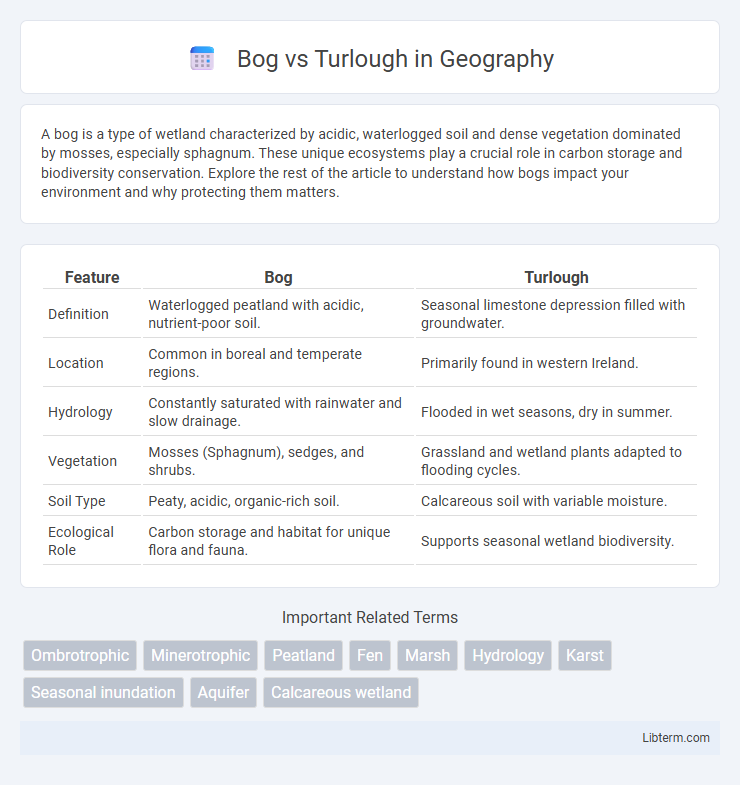A bog is a type of wetland characterized by acidic, waterlogged soil and dense vegetation dominated by mosses, especially sphagnum. These unique ecosystems play a crucial role in carbon storage and biodiversity conservation. Explore the rest of the article to understand how bogs impact your environment and why protecting them matters.
Table of Comparison
| Feature | Bog | Turlough |
|---|---|---|
| Definition | Waterlogged peatland with acidic, nutrient-poor soil. | Seasonal limestone depression filled with groundwater. |
| Location | Common in boreal and temperate regions. | Primarily found in western Ireland. |
| Hydrology | Constantly saturated with rainwater and slow drainage. | Flooded in wet seasons, dry in summer. |
| Vegetation | Mosses (Sphagnum), sedges, and shrubs. | Grassland and wetland plants adapted to flooding cycles. |
| Soil Type | Peaty, acidic, organic-rich soil. | Calcareous soil with variable moisture. |
| Ecological Role | Carbon storage and habitat for unique flora and fauna. | Supports seasonal wetland biodiversity. |
Introduction to Bog and Turlough
Bogs are waterlogged, peat-accumulating wetlands characterized by acidic, nutrient-poor conditions, predominantly found in cool, temperate regions. Turloughs are seasonal karstic lakes primarily found in limestone landscapes, filling with water during wet periods and draining in dry seasons. Both ecosystems support unique biodiversity and play significant roles in hydrology and carbon storage.
Definition of Bog
A bog is a type of wetland characterized by acidic, nutrient-poor water and the accumulation of peat, primarily composed of sphagnum moss. Unlike turloughs, which are seasonal karst lakes found in limestone areas, bogs maintain consistently saturated conditions due to poor drainage and precipitation inputs. These unique ecosystems support specialized plant species adapted to low-nutrient, waterlogged environments, playing a crucial role in carbon storage and biodiversity.
Definition of Turlough
A turlough is a type of seasonal lake found mainly in limestone karst regions of Ireland, characterized by its periodic flooding and drying due to underground drainage systems. Unlike permanent bogs, turloughs fill with water during wetter months and empty during dry periods, creating unique habitats for specialized plant and animal species. The intermittent nature of turloughs distinguishes them from bogs, which are peat-accumulating wetlands with consistently saturated soils.
Key Differences Between Bog and Turlough
Bogs are peat-accumulating wetlands characterized by acidic, waterlogged conditions and predominantly dominated by sphagnum moss, leading to slow decomposition rates and nutrient-poor environments. Turloughs are seasonal karst depressions found mainly in limestone regions, which periodically flood during wet seasons and dry out during droughts, creating unique habitats with fluctuating water levels. The key difference lies in their hydrology: bogs maintain consistently saturated conditions, while turloughs undergo cyclical flooding and drying influenced by groundwater and surface water dynamics.
Formation Processes of Bogs
Bogs primarily form in cool, wet climates where waterlogged conditions slow the decomposition of plant material, leading to peat accumulation. They develop over millennia as sphagnum moss and other vegetation create acidic, nutrient-poor environments that preserve organic matter. Unlike turloughs, which are seasonal karstic lakes formed by groundwater fluctuations in limestone regions, bog formation is largely driven by stagnant surface water and anaerobic soil conditions.
Formation Processes of Turloughs
Turloughs form primarily in karst landscapes through the dissolution of soluble limestone, creating underground drainage systems that temporarily flood depressions during wet seasons. Unlike bogs, which form from accumulated peat in waterlogged conditions, turloughs experience seasonal fluctuations as water table levels rise and fall, filling and emptying these natural basins. This dynamic hydrological process reflects the interaction of geology, groundwater flow, and surface water in shaping turlough ecosystems.
Ecological Importance of Bogs
Bogs are waterlogged ecosystems rich in sphagnum moss that play a critical role in carbon sequestration, storing vast amounts of carbon and mitigating climate change. Unlike turloughs, which are seasonal lakes predominantly influenced by groundwater fluctuations, bogs maintain stable acidic and nutrient-poor conditions supporting specialized flora and fauna such as carnivorous plants and peat-forming mosses. The ecological importance of bogs lies in their ability to preserve biodiversity, regulate hydrology, and act as natural archives of past climatic and environmental conditions.
Ecological Role of Turloughs
Turloughs serve a unique ecological role by providing seasonal wetland habitats that support specialized flora and fauna adapted to fluctuating water levels. These ephemeral water bodies contribute to biodiversity by offering breeding grounds for amphibians and refuge for aquatic invertebrates during wet phases, while supporting terrestrial species during dry periods. Unlike bogs, which maintain consistently acidic and waterlogged conditions, turloughs foster dynamic ecosystems critical for species reliant on periodic inundation and drying cycles.
Human Impact on Bogs and Turloughs
Human impact on bogs and turloughs significantly alters their ecosystems, with peat extraction and drainage lowering water tables and reducing carbon storage in bogs. Agricultural expansion and land reclamation threaten turloughs by disrupting seasonal flooding patterns critical for their unique habitats. Pollution and infrastructure development further degrade biodiversity, emphasizing the need for targeted conservation efforts to maintain these sensitive wetland environments.
Conservation Strategies for Bogs and Turloughs
Effective conservation strategies for bogs involve maintaining hydrological balance by preventing drainage and promoting natural water retention to sustain peat formation and carbon sequestration. Turlough conservation emphasizes protecting seasonal flooding patterns and water quality to preserve unique habitats and endemic species dependent on fluctuating water levels. Both ecosystems benefit from monitoring human impact and implementing restoration projects to enhance biodiversity and resilience against climate change.
Bog Infographic

 libterm.com
libterm.com